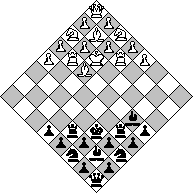MINOTAUR CHESS
v.1.1d
by Frank M. Truelove
with help from Rik Earnest and Adam Bragg
Named Minotaur Chess in part for the diagonally-moving piece "Minotaurus" (see A Guide to Fairy Chess by Dickins), Minotaur Chess is played on a Board set diagonally between two players. But most of the rules and backstory derive from a roleplaying campaign I ran from 1990-1996 called Chaos. And finally, a couple of trivial reasons for the name . . . I realized that my two other Chess Variants (Caissa's War and Campaign Chess, both still in progress) have names beginning with "C" already and I think Chaos Chess is taken.
Back-story
Alexander, a traveller between worlds, found himself on a world dominated by Minotaurs. In his attempts to change the social order of this new world (having successfully changed much of him own), he confronted the Minotaurs. Alexander was intent on ending the Minotaurs' domination of The New World.
Knowing that he could not beat his opponent physically, Alexander used Chess (a game from his homeworld) as his weapon in a battle of wits. He beat his adversary easily, winning "its" respect.
The defeated Minotaur took the game back to his people, but only after modifying it greatly.
 K=king (Chieftain); Q = Queen (Totem); B = Bishop (Shaman); N= Knight (Defender);
R = Rook (Champion); P = Pawn (Warrior); X = possible location for Vanguard
(Bishop).
K=king (Chieftain); Q = Queen (Totem); B = Bishop (Shaman); N= Knight (Defender);
R = Rook (Champion); P = Pawn (Warrior); X = possible location for Vanguard
(Bishop).
This Minotaur, Gadj by name, decided first that a King or "Chieftain" would not cower behind his weaker Warriors. He would lead them to glory. So Gadj would place the Chieftain in the front.
The "Chieftain" should be central, Gadj thought, and he turned the board so that he could place this central piece properly. The central Diagonal was the White one.
Though central, it is not the object of the game. Should the Chieftain die, another Warrior would surely succeed him. No, the Totem of the Tribe is the object. The eradication of the Totem will kill the Tribe. So Gadj made the Queen the "Totem" and placed it on the space nearest him on the long, central diagonal.
There was a space between the Totem and the Chieftain now. Gadj put the "Shaman", a Bishop originally, there.
To either side of the Chieftain, Gadj placed the Rooks. "Champions" he called them.
To either side of the Shaman, he put the "Defenders". These were the Knights of Alexander's game. And Gadj decided that Defenders shouldn't move until the Middle Game. (See Middle Game below)
He placed the Pawns so that the corner he was working from was neatly filled - one Pawn to the open side of the Champions, one full row of Pawns behind the front line and two pawns behind the Defenders and Shaman. He called the Pawns "Warriors".
The last piece, the remaining Bishop, became the "Vanguard". Since the "Shaman" had been placed on the central White diagonal, Gadj decided that the Vanguard should be placed on a Black Diagonal. It was then that he named the longest Black Diagonal the Border. The Vanguard is placed on any open Black space between (but not including) the Border and the Player's own Totem. Note, that the Vanguard can never attack the opposing Totem.
The first players who tried the game after Gadj invented it were Rodomon and Tade. Rodomon told Gadj that there were parts of the rules as outlined that were unclear. Gadj's first thought was to attack Rodomon for suggesting that Minotaur Chess was, in some way, inadequate. It was only Tade's suggestion that the game was `elegant' that prevented bloodshed that day.
Rodomon asked "Can the Vanguard occupy the border squares without awakening the Defenders?"
Gadj pondered this. Minotaur wars had in the past been precipitated by the mere sighting of a foe on the border. No one approaches one's border unless they wish to cross it, he thought. "Touching the border counts as crossing it," he answered.
Rodomon then asked "If the opposing Vanguard is taken before the Defenders are activated, do the Defenders remain statues permanently?"
Tade stated that he and Rodomon had ruled that this was so and they had played accordingly.
Gadj said, simply, "Yes."
PLAY
The Chieftain moves like a King.
The Champions move as Rooks.
The Vanguard and the Shaman move as Bishops, the Shaman always on a White Square and the Vanguard always on a Black one.
The Defenders cannot move until the opposing Vanguard crosses the Border. When they can move, they move as Knights.
Warriors move Diagonally to either side or forward. They are Unretreatable. They capture orthogonally.
The Totem cannot move.
If a Chieftain is taken, the nearest Champion promotes to Chieftain.
If a Champion is taken, the nearest Warrior Promotes to Champion.
If a Player's Totem is taken, all of his pieces save his Chieftain or one Champion are cleared from the board. This remaining piece becomes an Avenger and thereafter moves like a Queen.
OBJECT
Take your opponent's Totem and any Avenger created.
Written by Frank M. Truelove.
WWW page created: December 10, 1996. Last modified: February 25, 1999.